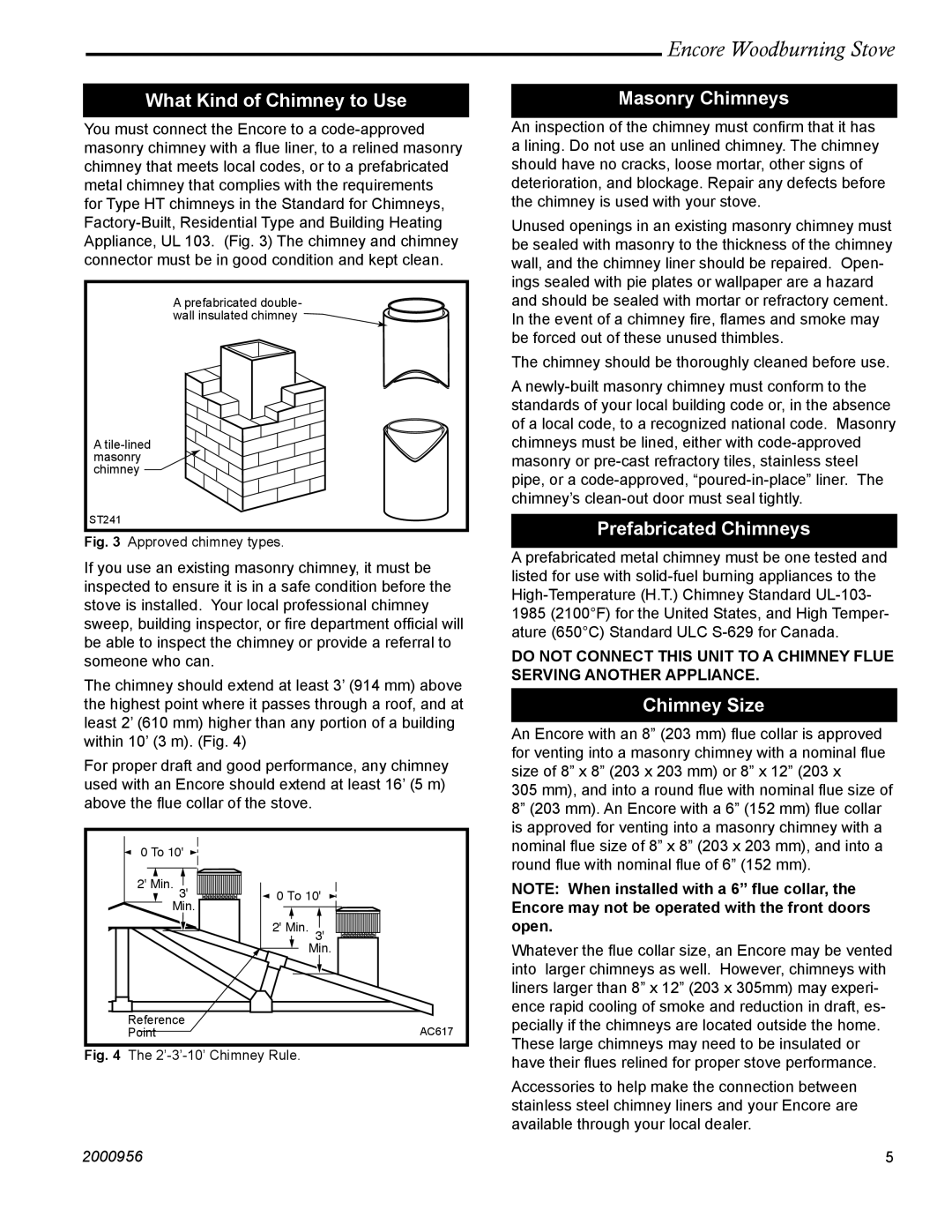
What Kind of Chimney to Use
You must connect the Encore to a
A prefabricated double- wall insulated chimney ![]()
A
ST241
Fig. 3 Approved chimney types.
If you use an existing masonry chimney, it must be inspected to ensure it is in a safe condition before the stove is installed. Your local professional chimney sweep, building inspector, or fire department official will be able to inspect the chimney or provide a referral to someone who can.
The chimney should extend at least 3’ (914 mm) above the highest point where it passes through a roof, and at least 2’ (610 mm) higher than any portion of a building within 10’ (3 m). (Fig. 4)
For proper draft and good performance, any chimney used with an Encore should extend at least 16’ (5 m) above the flue collar of the stove.
0 To 10' |
|
2' Min. 3' | 0 To 10' |
Min. |
|
| 2' Min. 3' |
| Min. |
Reference |
|
Point | AC617 |
Fig. 4 The 2’-3’-10’ Chimney Rule.
Encore Woodburning Stove
Masonry Chimneys
An inspection of the chimney must confirm that it has a lining. Do not use an unlined chimney. The chimney should have no cracks, loose mortar, other signs of deterioration, and blockage. Repair any defects before the chimney is used with your stove.
Unused openings in an existing masonry chimney must be sealed with masonry to the thickness of the chimney wall, and the chimney liner should be repaired. Open- ings sealed with pie plates or wallpaper are a hazard and should be sealed with mortar or refractory cement. In the event of a chimney fire, flames and smoke may be forced out of these unused thimbles.
The chimney should be thoroughly cleaned before use.
A
Prefabricated Chimneys
A prefabricated metal chimney must be one tested and listed for use with
DO NOT CONNECT THIS UNIT TO A CHIMNEY FLUE SERVING ANOTHER APPLIANCE.
Chimney Size
An Encore with an 8” (203 mm) flue collar is approved for venting into a masonry chimney with a nominal flue size of 8” x 8” (203 x 203 mm) or 8” x 12” (203 x
305 mm), and into a round flue with nominal flue size of 8” (203 mm). An Encore with a 6” (152 mm) flue collar is approved for venting into a masonry chimney with a nominal flue size of 8” x 8” (203 x 203 mm), and into a round flue with nominal flue of 6” (152 mm).
NOTE: When installed with a 6” flue collar, the Encore may not be operated with the front doors open.
Whatever the flue collar size, an Encore may be vented into larger chimneys as well. However, chimneys with liners larger than 8” x 12” (203 x 305mm) may experi- ence rapid cooling of smoke and reduction in draft, es- pecially if the chimneys are located outside the home. These large chimneys may need to be insulated or have their flues relined for proper stove performance.
Accessories to help make the connection between stainless steel chimney liners and your Encore are available through your local dealer.
2000956 | 5 |
